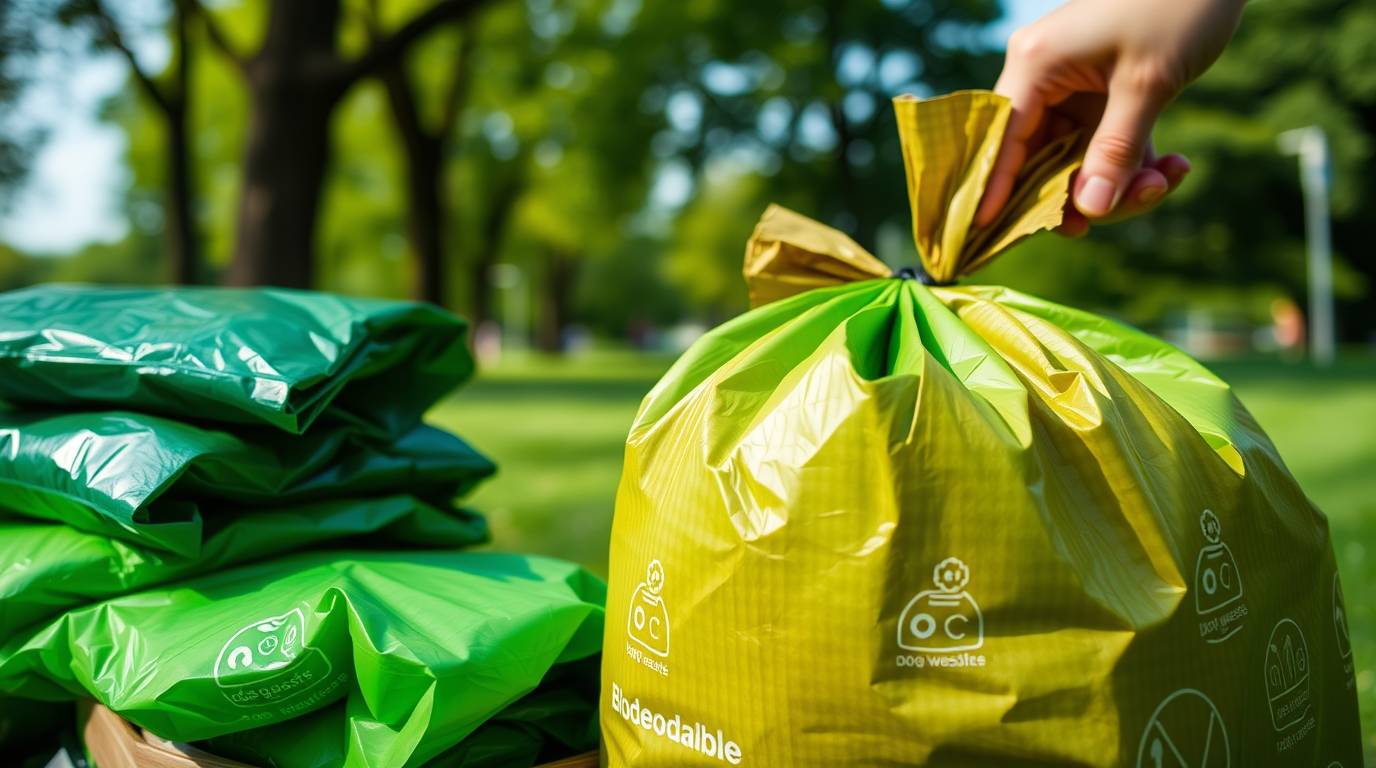Why is dog waste a National Emergency?
Dog Waste in the USA: The environmental impact of dog waste is remarkable. With 90 million dogs in the U.S., irresponsible disposal leads to water pollution, methane emissions, and public health crises.
Dog waste creates an awful environmental and public health crisis, with 90 million U.S. dogs generating 10,000+ tons of waste daily. According to the EPA, improper disposal fuels methane emissions (10 million tons of CO2-equivalent yearly) and contaminates 40% of waterways with harmful bacteria.
Pathogens like roundworms and giardia risk human health, while plastic pollution from poop bags continues for centuries. Addressing this requires urgent shifts to biodegradable bags, composting, and stricter waste management to control pollution, climate impact, and disease spread.
Key Statistics:
Eco-Friendly Dog Waste Disposal Methods:
Eco-friendly dog waste disposal methods are essential for reducing environmental harm. In the U.S., improper disposal of dog waste leads to water pollution, methane emissions, and health risks.
Sustainable alternatives, like biodegradable dog-waste bags, help ease these issues. Composting dog waste can also be an eco-friendly solution, turning waste into valuable fertilizer.
Additionally, pet owners can install dog waste disposal stations in parks, encouraging proper disposal. Investing in flushable dog waste systems and utilizing pet-safe waste digesters offer cleaner options for disposal.
These practices minimize negative environmental impacts while promoting responsible pet ownership. Reducing, recycling, and reusing dog waste is key to sustainability.
Biodegradable Dog Waste Bags vs. Plastic Bags.
- Biodegradable Bags: Break down in 3–6 months (look for ASTM D6400 certification).
- Compostable Bags Require industrial facilities; avoid home fertilizer baskets.
- Flushable Bags: Use only with septic-safe brands (e.g., FLUSH Puppies).
Avoid Plastic Bags:
- It takes about 500+ years to decompose.
- Contribute to plastic pollution from poop bags (6 billion plastic bags used yearly).
Dog Waste Removal Services:
- Weekly Service Subscriptions: Average cost: 15–15–25/week for 1–2 dogs.
- DIY Yard Cleanup: Use heavy-duty tools like the Foresight Stainless Scooper ($46.99).
Idea for You: Pair services with enzyme-based spray for dog poop odor (e.g., Rocco & Roxie) to neutralize smells.
Reducing Environmental Harm:
Dog waste significantly impacts ecosystems through methane emissions (28x more powerful than CO2) and water pollution from fecal bacteria. To ease this, divert waste from landfills through industrial composters or anaerobiotic digesters that break down organic matter safely.
Use compostable dog waste bags in EPA-approved systems to prevent groundwater pollution, and never dispose of waste near storm drains. A single gram of dog feces contains 23 million bacteria, aggressive aquatic life, and human health.
Prioritize wrapped composters like the Green Cone Digester and enzyme treatments to neutralize pollutants, ensuring eco-safe disposal while curbing climate and water-quality risks.
Methane Emissions & Climate Impact:
Decomposing waste in landfills produces methane, a gas 28x more powerful than CO2.
Solution: Divert waste to industrial composters or anaerobic digesters.
Preventing Water Pollution:
1 gram of dog feces contains 23 million fecal coliform bacteria (EPA).
Prevent Runoff:
- Use compostable dog waste systems.
- Never dispose of waste near storm drains.
Health Risks & Safe Practices:
Dog waste harbors dangerous pathogens like roundworms (10,000 human infections yearly) and giardia, posing serious public health risks. The EPA underlines using biodegradable dog waste bags and hot composting (140°F+) to kill pathogens.
Always sanitize shoes after walks and vaccinate pets monthly to reduce disease spread.
For odor control, apply enzyme-based sprays to break down waste safely. Avoid burying waste in gardens and follow EPA guidelines for disposal to protect soil and water quality.
Sustainable pet ownership demands these practices to alleviate zoonotic diseases, bacterial pollution, and long-term environmental harm.
Pathogens in Dog Waste:
- Roundworms: 10,000 human infections/year (CDC).
- Giardia: Causes severe looseness.
Prevention:
- Sanitize shoes after walks.
- Vaccinate pets monthly.
EPA Guidelines for Dog Waste Disposal:
- Do: Use biodegradable bags, compost through hot systems (140°F+).
- Don’t bury waste in vegetable gardens or use standard trash bags.
Composting Dog Waste Safely:
Composting dog waste requires strict proprieties to neutralize pathogens. Use dedicated composters like the Green Cone Digester (160) or Doggie Dooley (160) or Doggie Dooley (80), maintaining 140°F+ temperatures to kill roundworms and bacteria.
Add bokashi bran or enzyme accelerators to break down waste efficiently, and only compost in attractive gardens (never eatable harvests). EPA guidelines order to avoiding standard compost bins, as home systems rarely sustain adequate heat.
Pair compostable dog waste bags with industrial facilities for safe processing. This method diverts landfill waste, cuts methane emissions, and transforms feces into non-edible soil changes—critical for eco-friendly disposal without health risks.
How to Compost Dog Waste Safely?
- Use a dedicated compost bin (avoid mixing with food scraps).
- Maintain temperatures above 140°F to kill pathogens.
- Add bokashi bran or enzyme-based sprays to accelerate breakdown.
Caution: Compost only for non-edible plants (attractive gardens).
Best Composting Tools:
- Green Cone Digester ($160): Solar-heated system for residential homes.
- Doggie Dooley ($80): Simple burial system with enzyme tablets.
Sustainable Products & Tools:
Choose eco-friendly dog products like ASTM D6400-certified biodegradable dog waste bags (Earth Rated, Green Paws) and heavy-duty tools such as the Foresight Stainless Scooper.
Premium options like the Green Cone Digester ($160) safely break down waste, while affordable weekly dog waste removal services reduce landfill dependence. Prioritize products authorized by EPA guidelines to balance efficacy, cost, and environmental impact.
Eco-Friendly Dog Products:
- Biodegradable Bags: Earth Rated (EPA-recommended).
- Metal Dog Waste Scooper for Large Breeds: Foresight Stainless ($46.99).
- Odor Control: Nature’s Miracle enzyme spray ($27.18).
Budget vs. Premium Picks:
| Product | Budget | Premium |
| Scoopers | Four Paws ($12) | Foresight ($47) |
| Bags | Amazon Basics | Green Paws ($18) |
| Composters | DIY Bin ($50) | Green Cone ($160) |
Policy & Community Action:
Effective waste management demands policy reform and popular efforts. Activist for biodegradable bag dispensers in parks, demonstrated after Seattle’s program reduced plastic use by 62%.
Push local leaders for tax rebates for compostable bags and stricter fines for repeat criminals, like Denver’s $150 penalty. Communities can leverage EPA guidelines to petition for industrial composting subsidies or city-funded waste stations.
Report culprits through apps like NYC 311 and organize “Scoop-a-Thon” cleanups to tag hotspots on shared maps. Collective action bridges gaps in public resources, driving submission with eco-safe practices while cutting methane emissions and public health risks.
Advocating for Change:
- Demand Biodegradable Bag Dispensers in parks (template email provided in original article).
- Request for Tax Repayments on compostable bags (e.g., Seattle’s program).
Dog Waste Removal Services Near Me:
- Search Tips: Use terms like “affordable pet waste removal” + [your city].
- National Companies: Poop 911, Scoop Troop.
Dog Waste vs. Human Waste Environmental Impact:
- Dog waste has 2x more bacteria per gram than human waste (EPA).
- Not processed in sewage systems, increasing contamination risks.
Biodegradable Bags for Septic Systems:
- Use FLUSH Puppies or similar brands labeled “septic-safe.”
- Avoid blockage pipes; only 1–2 bags/day.
Final Checklist: 7-Day Action Plan:
Day 1: Switch to biodegradable dog waste bags.
Day 3: Buy a metal dog-waste scooper.
Day 5: Research dog waste removal services.
Day 7: Start composting with a Green Cone Digester.
Conclusion:
Tackling America’s dog waste crisis requires adopting eco-friendly dog products, following EPA guidelines, and using sustainable disposal methods. From biodegradable bags to composting systems, every action reduces methane emissions and water contamination.
Be a part of the solution—your planet and pets will thank you.

